Annual UK Peregrine Watch Scheme in Northern Ireland hailed a success
Following the successful launch of Operation Raptor in March 2016 the PSNI have continued to show their commitment to tackling wildlife crime by contributing to a UK initiative named “Peregrine Watch” throughout 2017.
Peregrine Watch is an ongoing initiative to prevent and stop any peregrine persecution and this can include theft of eggs and chicks from nests and/or the killing of adults and/or chicks through poisoning, shooting or trapping at any time of the year.
The PSNI have been using the latest technology to help prevent and combat wildlife crime. Small Unmanned Aircraft(SUA), more commonly known as ‘drones’, fitted with specialist cameras, have been used throughout the nesting season to monitor ‘hot-spot’ areas across Northern Ireland where crimes against birds of prey.
The Northern Ireland Raptor Study Group (NIRSG), who monitor peregrine breeding sites every year across Northern Ireland, have said “There was a very clear reduction in the number of persecution incidents recorded at peregrine sites this year. The average number of successful nests in Northern Ireland each year is 49 – in 2017 there were 55.
Among these was a nest site in Co. Armagh at which persecution has been recorded for at least the past 30 years, and for the first time in 15 years a pair of peregrines at this site was successful in producing young. In total, 138 peregrine chicks have fledged this year, compared to the average annual production of 109. We still recorded a number of suspected persecution incidents, but overall this was certainly lower than in an ‘average year’.”
PSNI Wildlife Liaison Officer, Emma Meredith, said, “We are delighted to have been of assistance in the fight against wildlife crime, and are pleased to be able to continue to work with our partners. As far as we are aware, the Police Service of Northern Ireland is one of the first Police Services in the UK to use this technology in this way. We are pleased to be able to effectively target hotspot areas and areas further afield as and when required so we can work with our partners in the hope that we can all prevent this type of crime and reach our ultimate goal to combat wildlife crime.
She continued “The Police Service of Northern Ireland take all types of crime seriously and this includes wildlife crime such as shooting, poisoning or trapping of birds of prey. On occasions, baits (examples such as a rabbit carcass or sausages) have been laid laced with poison in the public domain. Be under no illusion that some poisons could also be fatal to humans, not only wildlife suffers but also any child, adult or pet could find and ultimately consume poisoned baits. Given the potential dangers of this and other poisons, for the first time PSNI began to use the PSNI drones fitted with specialist cameras to assist in prevention and if possible catching the perpetrators, who if caught will be reported to the Public Prosecution Service. I would also ask if anyone find what they suspect to be a poisoned bait or suspicious dead bird to leave it in situ and call the police on 101.”
Sgt. Scott Fallis said, “I was very happy to be involved with Peregrine Watch, and have been involved with NIRSG scientists over the last couple of breeding seasons in monitoring nest sites, and ringing peregrine chicks. This is an element of wildlife crime which PSNI take very seriously to ensure these birds are protected for future generations to enjoy. We will robustly investigate any form of persecution of these birds not only at nesting time but throughout the year, alongside any other protected species.”
The NIRSG additionally said “The impact of the Peregrine Watch initiative in its pilot year on the successful breeding of peregrines has been very positive. The peregrine population here in Northern Ireland is already under pressure from many natural causes but we also lose a number each year to illegal poisoning, shooting and trapping, particularly during the nesting season when they are most vulnerable. The use of drones has enabled the PSNI to survey hard to reach areas, meaning there is no hiding place for wildlife criminals who seek to persecute these protected birds.”
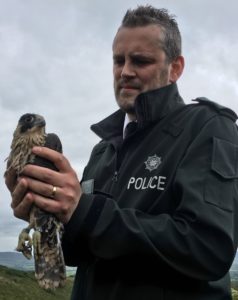
NIRSG scientists, along with PSNI officers, were also able to carry out the fitting of leg-rings, under special licences, at a number of sites across the country, as part of ongoing research studies on this species. In addition to the monitoring carried out by PSNI, NIRSG scientists have also been installing covert cameras under licence, in order to monitor adults and nestlings and to identify individual peregrines, including those which are fitted with leg rings. There have been great results recorded at a number of sites, including identifying a female peregrine by her leg rings, originally born in Co. Kildare, which had two chicks this year in Co. Armagh. This information contributes to knowledge about the movements of peregrines and their survival, and ongoing monitoring by remote cameras across Northern Ireland will continue indefinitely.
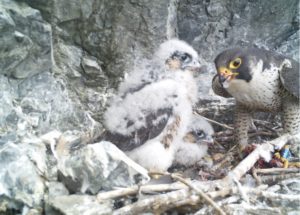
UK hen harrier population suffers decline, according to latest figures
 1) Latest hen harrier survey reveals UK population in 2016 of 545 territorial pairs, a drop of 88 pairs since the last national survey in 2010.
1) Latest hen harrier survey reveals UK population in 2016 of 545 territorial pairs, a drop of 88 pairs since the last national survey in 2010.
2) Scotland remains the stronghold for the UK hen harrier population, with 460 pairs.
3) In England the hen harrier remains on the brink of extinction as a breeding species with just four territorial pairs in 2016. Northern Ireland and Wales also both report a decline in numbers in the past six years.
4) Longer term figures show dramatic decline of 204 pairs (39%) in the last twelve years.
The hen harrier population has suffered a decline of 88 pairs (13%) over the past six years with a total UK population estimated to be 545 pairs, according to the latest figures from the fifth national hen harrier survey.
Known for their majestic skydancing ritual, this graceful bird is one of the most threatened birds of prey in the UK. Historically hen harriers were once a much more widespread breeding species before they were driven to extinction in mainland Britain during the 19th century. Despite its comeback, the species has remained rare in the UK with a breeding population under 1000 pairs making it vulnerable to the effects of habitat loss, weather and illegal killing.
Scotland remains the stronghold for UK hen harriers with an estimated 460 pairs in 2016, around 80 per cent of the UK population. This estimate is nine per cent below the best estimate in 2010 of 505 pairs. The west Highlands continue to provide a home for the majority of Scotland’s breeding harriers (estimated 175 breeding pairs), while Orkney and the Hebrides were the only areas of the country to show a slight increase in the number these birds.
The survey also revealed that the hen harrier remains on the brink of extinction as a breeding species in England as the population fell from 12 pairs in 2010 to just four pairs last year. Estimates from the Joint Nature Conservation Committee (JNCC) suggest there is potential habitat to support at least 300 pairs of hen harrier in England, highlighting the desperate situation they face.
The hen harrier population had been slowly recovering in Wales since re-colonising in the late 1950s but the latest figures show that the number of pairs has fallen by more than a third over the past six years, from 57 to 35. This is the lowest population that has been seen in Wales for over a decade.
With 46 pairs, Northern Ireland also experienced a decline in pairs after 59 were recorded in the previous survey. Hen harriers were also surveyed on the Isle of Man, in partnership with Manx BirdLife, with numbers remaining stable at 30 pairs, up one on the 2010 total.
Longer term figures highlight the dramatic decline the UK hen harrier population has suffered over the past twelve years. The national survey in 2004 pointed to an estimated 749 pairs, meaning hen harrier numbers have fallen by 204 pairs (39%) in the years following.
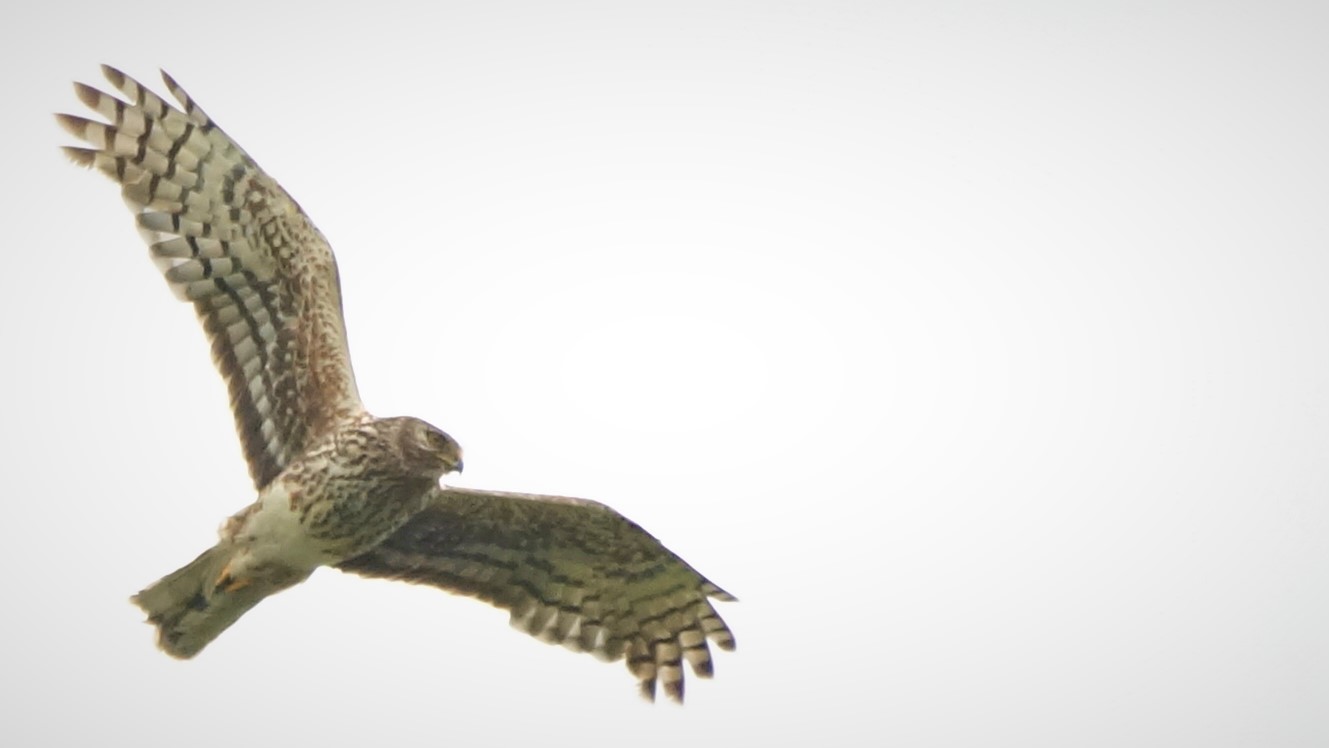
Martin Harper, RSPB Conservation Director, said: “The hen harrier is one of our most wonderful birds of prey, to see one soaring through the air before dramatically diving down during its thrilling skydancing display is an iconic sight and one that will always take your breath way. These are sights that we should all be able to enjoy. Unfortunately, we are being robbed of the chance to see these beautiful birds flourish throughout the UK countryside.”
The reasons for the population changes are likely to be a combination of factors that vary from region to region. From previous research, it is known that the main factor limiting the UK hen harrier population is illegal killing of these birds associated with driven grouse moor management in northern England and parts of mainland Scotland. Other pressures such as cold and wet weather conditions over a number of breeding seasons, changes in habitat management and low prey abundance could have all had an impact on numbers throughout the UK.
Martin Harper added: “The latest figures back up a continued trend that we have seen for more than a decade – hen harrier numbers are on the decline throughout the UK. The illegal killing of this bird of prey is a significant factor behind the diminishing numbers and a large barrier stopping their recovery. Without purposeful action from all, including governments across the UK and the shooting industry, we may see hen harriers once again lost from more parts of the country.”
The UK wide survey was carried out from the beginning of April to the end of July last year and as a partnership between RSPB, Scottish Natural Heritage (SNH), Natural Resource Wales (NRW), Natural England (NE), the Northern Ireland Environment Agency, the Scottish Raptor Study Group, the Northern Ireland Raptor Study Group, Northern England Raptor Forum and Manx BirdLife. It was co-funded by SNH, NRW and RSPB with the fieldwork being carried out by expert licensed volunteers and professional surveyors.
Eileen Stuart, Scottish Natural Heritage Head of Policy & Advice, said: “While Scotland remains the stronghold for hen harriers in the UK, the continuing decline is a serious concern particularly the low numbers found in parts of the mainland. We’re committed to continuing to work with a wide range of partners to tackle wildlife crime through PAW Scotland, including initiatives such as Heads up for Harriers, and General Licence restrictions where evidence supports such action. Scottish Natural Heritage and Forestry Commission Scotland have set up a joint Raptor Working Group to identify and promote the opportunities of forestry for raptors, including hen harriers, to sustainably deliver Scottish Government environmental and forestry policy.”
Simon Wotton, lead author of the study, said: “This UK-wide survey required a monumental effort from a number a number of different funders, organisations and volunteers – without their help, dedication and expertise we wouldn’t be able to build up this accurate picture of these magnificent birds of prey. We hope these results will convince all those who are in a position to help hen harriers to take positive steps to ensure their protection and rebuild the UK’s hen harrier population for people to enjoy for generations to come.”
Annual UK Peregrine Watch Scheme begins in Northern Ireland
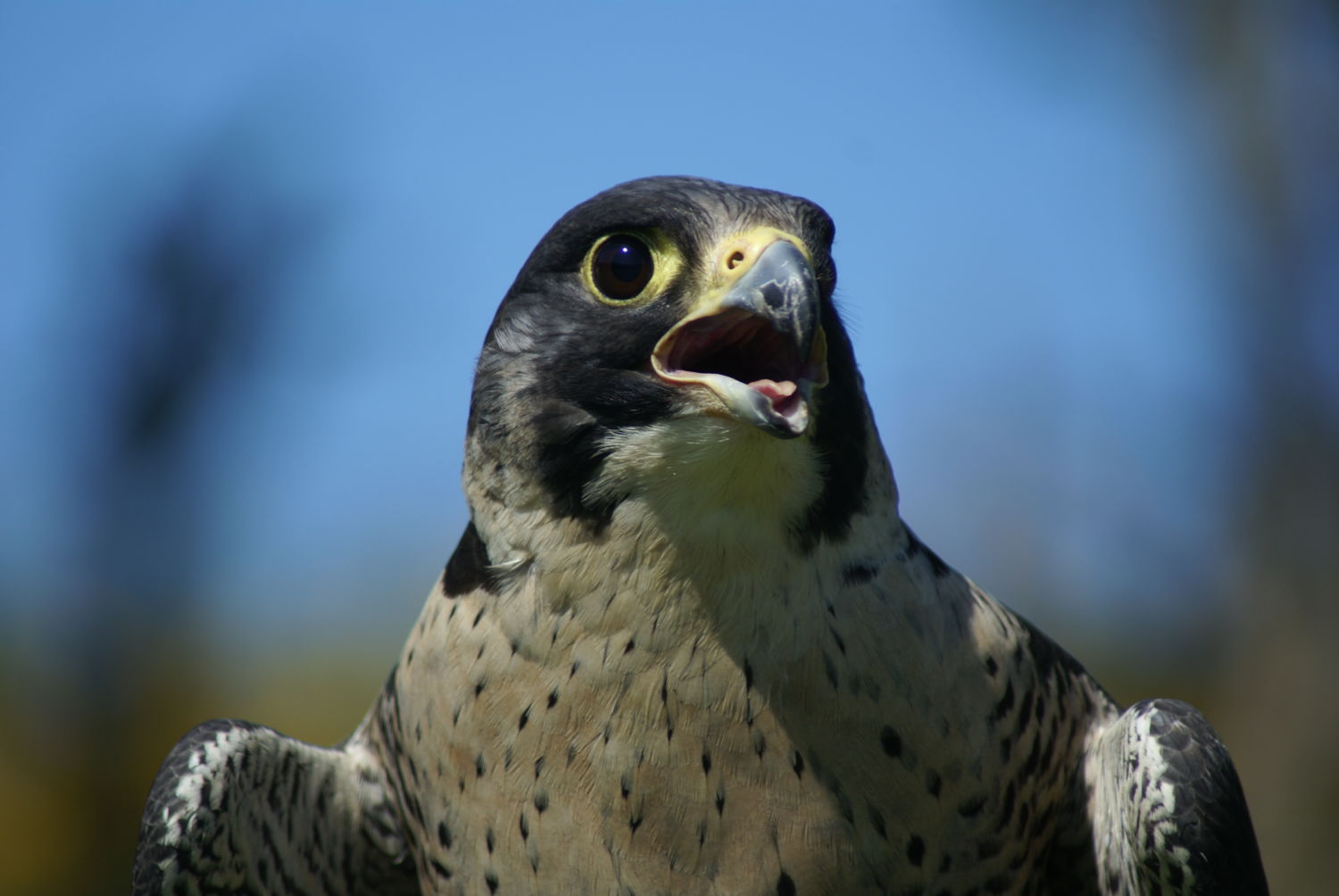
Peregrine Watch is an initiative to stop any peregrine persecution and this can include theft of eggs and chicks from nests and/or the killing of adults and/or chicks through poisoning, shooting or trapping.
Sgt Fallis, PSNI Fermanagh and Omagh District Community Planning, stated; “We have locally pro-actively built excellent relations with the Raptor Study Group in Northern Ireland who monitor and visit all the Peregrine nest sites in Northern Ireland each year and as such, through the appropriate licences, we, along with the raptor group, are checking local nests to ensure crimes against these birds is minimised and that we are familiar with our local protected species. The PSNI take all reports of wildlife crime seriously and as such if we receive a report linked to peregrine watch we will respond accordingly. If anyone has information on any type of crime against birds of prey please contact 101”.
Dr Marc Ruddock & Mr Cliff Dawson, two of the peregrine surveyors for Northern Ireland Raptor Study Group (NIRSG) who have been out surveying with PSNI officers both have welcomed the initiative saying; “The NIRSG welcomes the PSNI initiative locally especially since we lose a number of peregrines each year, particularly to illegal poisoning or shooting. We are spending time with local PSNI officers again this year surveying peregrine sites, ringing chicks and liaising with landowners in order to prevent crimes against these birds. As always we would urge anybody who notices any suspicious activity particularly near quarries or cliffs to the PSNI to help thwart these wildlife criminals”.
Chief Inspector Martin Sims of the National Wildlife Crime Unit stated that, “In many parts of the UK, the Peregrine is under real threat for a number of reasons. These include persecution, whether that be shooting, poisoning or trapping of both peregrine adults and chicks or theft of nestlings. This is totally unacceptable and I am really pleased to see all the efforts that Northern Ireland are making to try and prevent the persecution of Peregrines happening in any circumstance”.
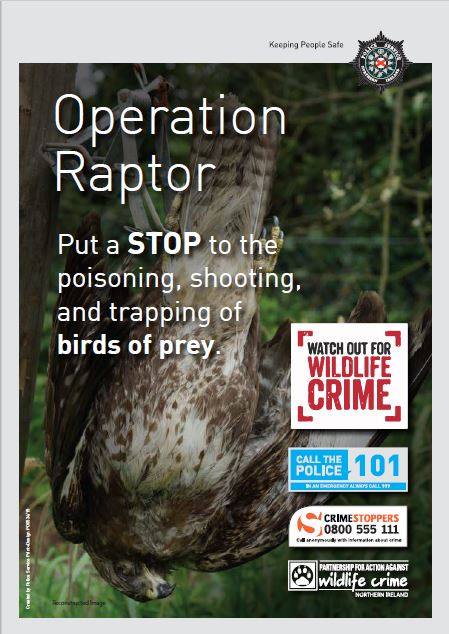
NI raptor deaths rise, new report reveals
A report into the illegal killing of Northern Ireland’s native birds of prey has been published by the Partnership for Action against Wildlife Crime. It reveals there were nine confirmed illegal poisoning or persecution incidents, affecting 11 protected birds of prey, in Northern Ireland in 2014. This report follows on from the 2009 – 2013 Persecution Report published last year. Between 2009 and 2014 there is now a total of 44 confirmed reports of native birds of prey being illegally killed, plus one confirmed incident of illegal nest destruction.
 The report examines occurrence and trends in persecution of these birds, which has allowed PAW to produce ‘hot-spot’ maps to identify areas where crimes against birds of prey are occurring. Of the nine confirmed cases in 2014, four of these occurred in County Down, two in County Tyrone and one in each of counties Londonderry, Armagh and Antrim. The report shows that the most frequent casualties were buzzards and the recently re-introduced red kite, with four of each of these species killed. Red kites and buzzards are particularly susceptible to poisoned baits as they will scavenge on carrion routinely. There were also two peregrine falcons and a sparrowhawk killed.
The report examines occurrence and trends in persecution of these birds, which has allowed PAW to produce ‘hot-spot’ maps to identify areas where crimes against birds of prey are occurring. Of the nine confirmed cases in 2014, four of these occurred in County Down, two in County Tyrone and one in each of counties Londonderry, Armagh and Antrim. The report shows that the most frequent casualties were buzzards and the recently re-introduced red kite, with four of each of these species killed. Red kites and buzzards are particularly susceptible to poisoned baits as they will scavenge on carrion routinely. There were also two peregrine falcons and a sparrowhawk killed.
Four of the incidents involved the use of the highly toxic pesticide ‘Carbofuran’, which has been banned across the EU since 2001. The poison has often been laid illegally to target ‘pest species’ and the birds of prey have fallen victim to its indiscriminate use. However some species or nests have been specifically targeted. Seven birds also tested showed detectable levels of secondary poisoning by rodenticides (bromadiolone, brodifacoum, difenacoum, and/or flocoumafen) – suggesting that these birds have eaten rodents that have ingested rodenticides. The levels of these chemicals were not deemed to have been the primary cause of death of these birds but highlight that there is misuse of ‘over the counter’ pesticides across Northern Ireland. Users must always read and adhere to the label instructions of the pesticide; they should collect and correctly dispose of any rodent carcasses daily.
Commenting on the report, Minister for Agriculture, Environment and Rural Affairs (DAERA) Michelle McIlveen MLA, said: “This report highlights the ongoing disregard for the safety of people and animals in our countryside through the illegal use of highly toxic poisons.
“The loss of vulnerable birds of prey to acts of persecution is extremely worrying, as they are a keystone species in our ecosystem and play an important role in the natural order. Maintaining and enhancing biodiversity is a central objective of my Department. I call on those responsible for these reckless acts to cease doing so and I urge anyone who may have information about these crimes to contact the PSNI or Crimestoppers.”
Superintendent, Brian Kee, PSNI service lead for rural and wildlife crime added: “It isn’t acceptable for birds of prey or any other wildlife to be killed in this way. These actions are illegal and the use of toxic poisons is indiscriminate as they put children, pets and livestock at risk too. I would urge anyone with any information on these types of crimes to report this to the PSNI on 101 or anonymously via Crimestoppers on 0800 555 111 and be assured of PSNI continued efforts in the tackling of wildlife crime.”
The report lead author, Dr Eimear Rooney (Raptor Officer for NIRSG) commented: “This is the second report which maps the confirmed bird of prey persecution incidents in Northern Ireland. It is great to have the partner agencies working closely together to combat raptor persecution. This report helps us all to understand the scale and distribution of the problem. It is heart-breaking to think of the deaths of these birds but it is particularly shocking to see the continued usage of highly toxic Carbofuran.”
The raptor persecution and poisoning report for 2014 can be downloaded at the following link: 2-paw-rs-persecution-report-2014_final
- Raptor Persecution is one of the UK Government’s top six Wildlife Crime priorities. Raptor crimes typically comprise illegal poisoning, shooting or trapping events and may occur at any time of the year. It is also illegal to cause disturbance to all breeding raptors or damage their nests or eggs.
- The Raptor Priority Subgroup comprises Police Service of Northern Ireland (PSNI); Northern Ireland Environment Agency (NIEA); National Wildlife Crime Unit (NWCU); Northern Ireland Raptor Study Group (NIRSG); the Royal Society for Protection of Birds (RSPB); Agri-food and Biosciences Institute (AFBI) and the Health and Safety Executive for Northern Ireland (HSE NI). The Raptor Priority Sub-Group is acting on behalf of and reports back to the main PAW NI steering group currently chaired by the NIEA
- Wildlife legislation, namely the Wildlife (Northern Ireland) Order 1985 as amended by the Wildlife and Natural Environment (NI) Act 2011 protects birds of prey from disturbance and/or destruction by special penalties. Penalties can include a custodial sentence and/or up to a £5,000 fine per offence. All raptors are listed on Schedule 1 of the order and there are six raptor species which receive additional protection on Schedule A1 which protects their nests from disturbance or destruction at all times of the year. Schedule A1 includes peregrine falcon, red kite, barn owl, golden eagle white-tailed eagle and osprey.
- In March 2016 the PSNI, in partnership with the PAWNI Raptor Subgroup members, launched ‘Operation Raptor’. This campaign was developed as a direct result of the publication of the first Bird of Prey Persecution and Poisoning Report, covering the period 2009 – 2013. The ‘Operation Raptor’ campaign is designed to encourage people to report potential crimes to PSNI and also to warn offenders they could face a custodial sentence and/or a fine (up to £5,000 per offence) if they are caught targeting birds of prey through poisoning, shooting or trapping. Operation Raptor posters are being distributed into ‘hot spot’ areas to highlight the illegal practises to local members if the public, to act as a deterrent to those who seek to kill birds of prey.
- The Campaign for Responsible Rodenticide Use (CRRU) aims to promote best practice so that rat poisons (rodenticides) in particular should not get into the wildlife food chain where it harms owls, kites and other birds of prey. More information on this can be found at www.thinkwildlife.org
- A leaflet outlining the protocol for reporting raptor crimes was previously produced by the Raptor Subgroup and is available for download at the following link: https://www.nirsg.com/wp-content/uploads/2014/02/PAWNI-Raptor-Crime-Leaflet.pdf
- The Bird of Prey Persecution and Poisoning Report 2009-2013, produced by the Raptor Subgroup in November 2015, can be downloaded at the following link: https://www.psni.police.uk/globalassets/advice–information/animal-welfare/documents/pawni-raptorpersecution–poisoning-report-2009-2013-final.pdf
- More information on the public campaign to ‘Watch Out For Wildlife Crime’ in Northern Ireland can be found at www.wildlifecrimeni.org
- More information on the Wildlife Incident Investigation Scheme (WIIS) is available at: http://www.pesticides.gov.uk/guidance/industries/pesticides/topics/reducing-environmental-impact/wildlife
HEN HARRIER DAY NI 2016
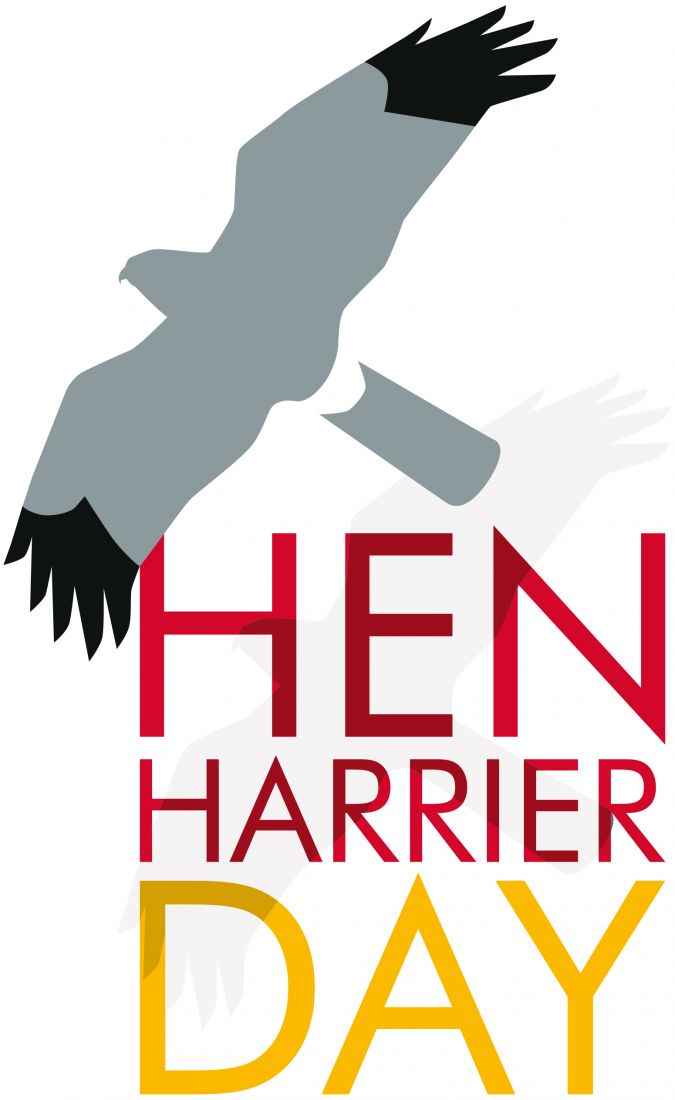 Across the UK and further afield hen harriers are considered to be missing from suitable habitat due to multiple threats and in particular as a direct result of persecution.
Across the UK and further afield hen harriers are considered to be missing from suitable habitat due to multiple threats and in particular as a direct result of persecution.
Birders Against Wildlife Crime (BAWC) coordinated ‘Hen Harrier Day’ in a bid to celebrate this wonderful raptor species and raise awareness of the plight of the hen harrier and to encourage people to make their voices heard. Hen Harrier Day aims to show those who continue to persecute hen harriers, and other raptor species, that it will not be tolerated.
In Northern Ireland & the Republic of Ireland our hen harriers are not known to be as heavily persecuted as those in Britain, it has nonetheless been recorded. However localised disturbance issues, predation, food availability and wide-scale habitat factors may also be having an impact on the numbers and breeding success of harriers locally. The population here has declined over time and there appears to be far fewer chicks fledging in recent years.
As fewer chicks are produced to enter the breeding population we may see population numbers reduce further. Our hen harrier population also depends on birds coming in from Britain to join our population and if hen harriers are reduced or disappear from Britain then it may directly impact on our birds too.
The NIRSG hosted two Hen Harrier Day events in Northern Ireland on behalf of BAWC on Saturday 6th August 2016 as part of celebrations across the UK. Alan Ferguson, volunteer with NIRSG, says ‘Although this is the third Hen Harrier Day it is the first time NIRSG have hosted an event. We want to raise the profile of the issues surrounding the decline of hen harriers and we had a good turnout for our first day. Our native wildlife should be allowed to thrive so everyone can enjoy it. We are so grateful to everybody who joined us on Saturday 6th August to ‘Make a Stand for Hen Harriers’.
Phil Walton from BAWC says “The first Hen Harrier Day in 2014 was a collaboration between BAWC, Mark Avery and Chris Packham to raise awareness of the plight of these iconic birds of prey. Despite full legal protection since the early 1950s, Hen Harriers remain absent from vast swathes of the UK uplands. They are now almost extinct as a breeding species in England, primarily because of illegal persecution. Hen Harrier Day is now an annual fixture, growing from three main events just two years ago to 12 this year. The support we have received from the Northern Ireland Raptor Study Group has been fantastic. For them to have two events organised in their first year of participation is a great achievement.”
The events were open to everyone and offer a chance to show our solidarity for all hen harrier populations in the UK & Ireland, celebrate that we have this wonderful raptor in our uplands and show the wider public that we are not afraid to speak out and that we will not tolerate persecution.
Saturday 6th August 2016 saw Hen Harrier Day celebrations take place at Glenarriff Forest Park, Co. Antrim in the morning and Castle Archdale Country Park, Co. Fermanagh in the afternoon. Dozens of people joined us and made banners and posters to join in the celebration. We thank all those who helped in organising the event and particularly those who attended.
We all had a fantastic day celebrating the Hen Harrier – the Sky Dancer.
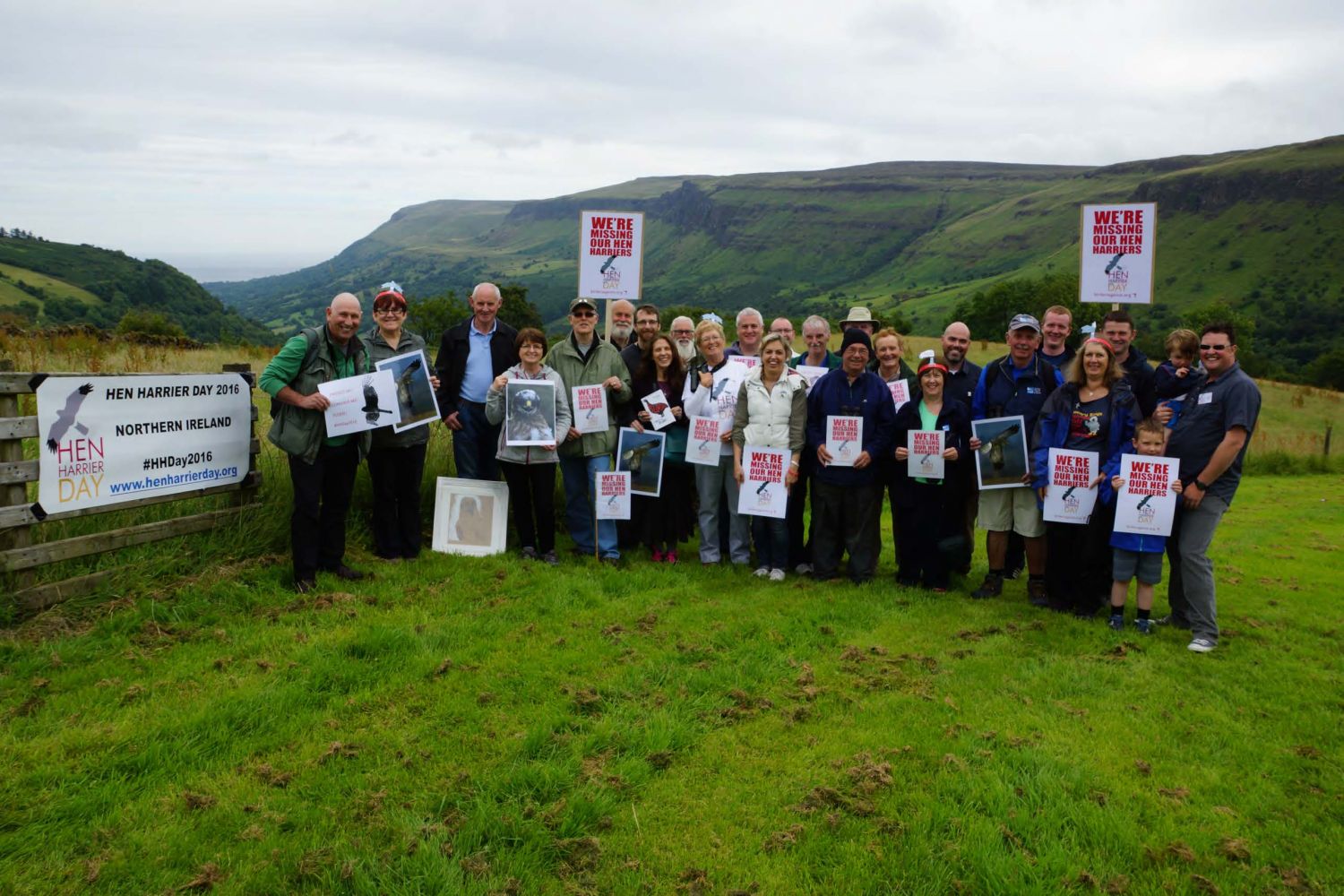
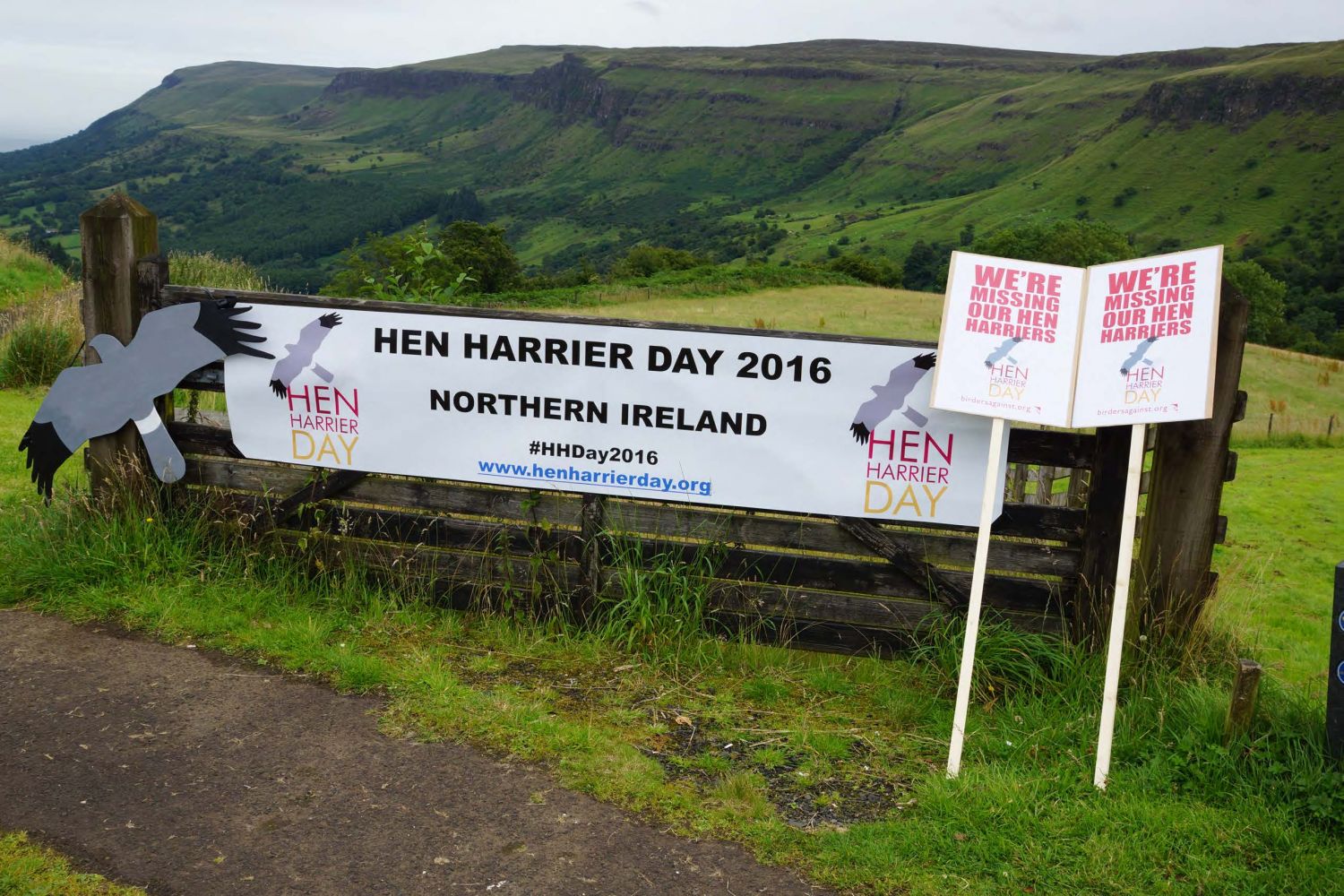
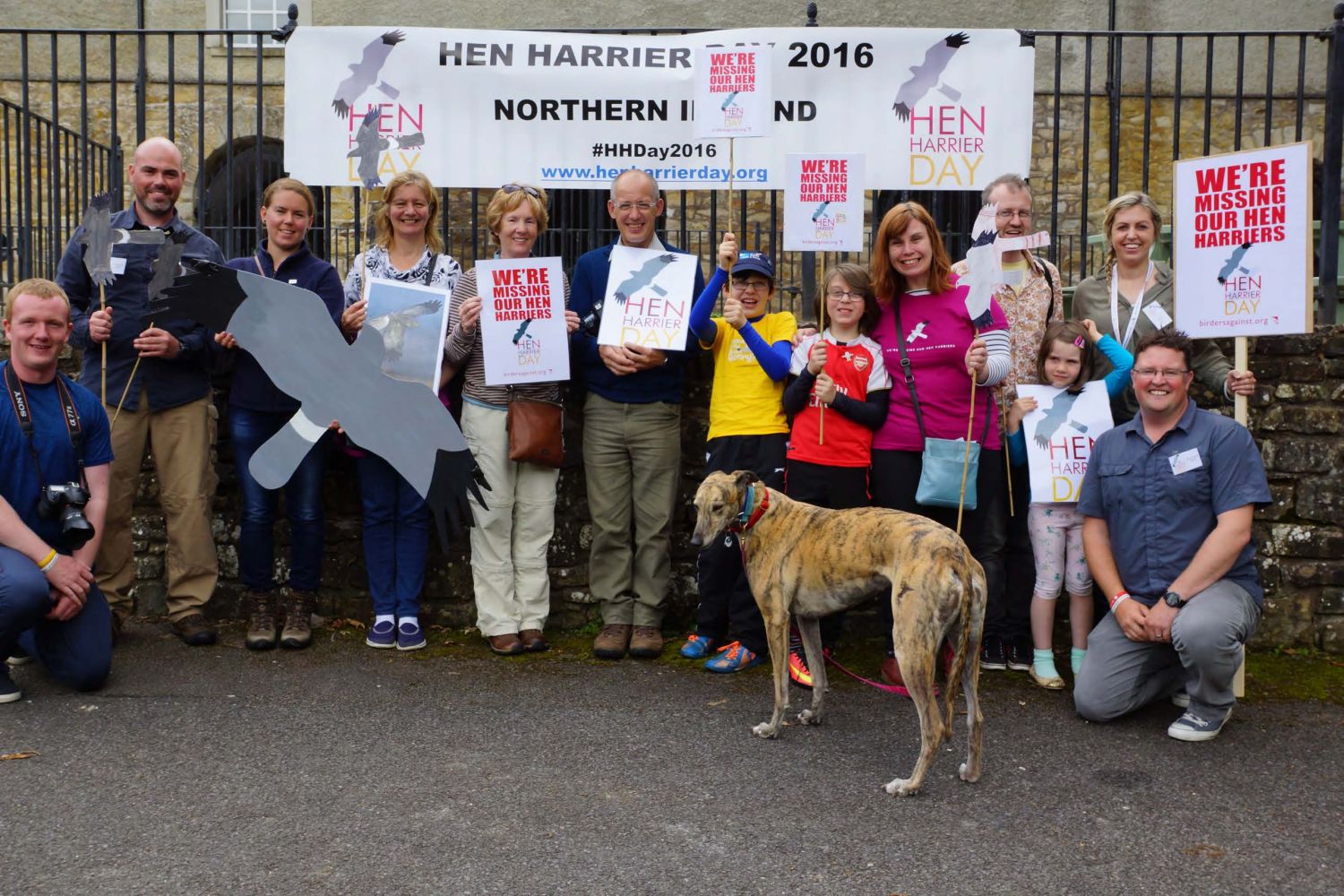
Bird Of Prey Disturbance & Legislation
During the breeding season many animals defend their territories and breeding sites from potential danger and birds of prey are no exception. Birds of prey will ‘alarm call’ at any perceived threat that comes too close to the nest site. On rarer occasions they may dive at the threat if it persists. This is a natural response which can be observed by many different types of wildlife. For example, many of us are familiar with being ‘dive-bombed’ by gulls.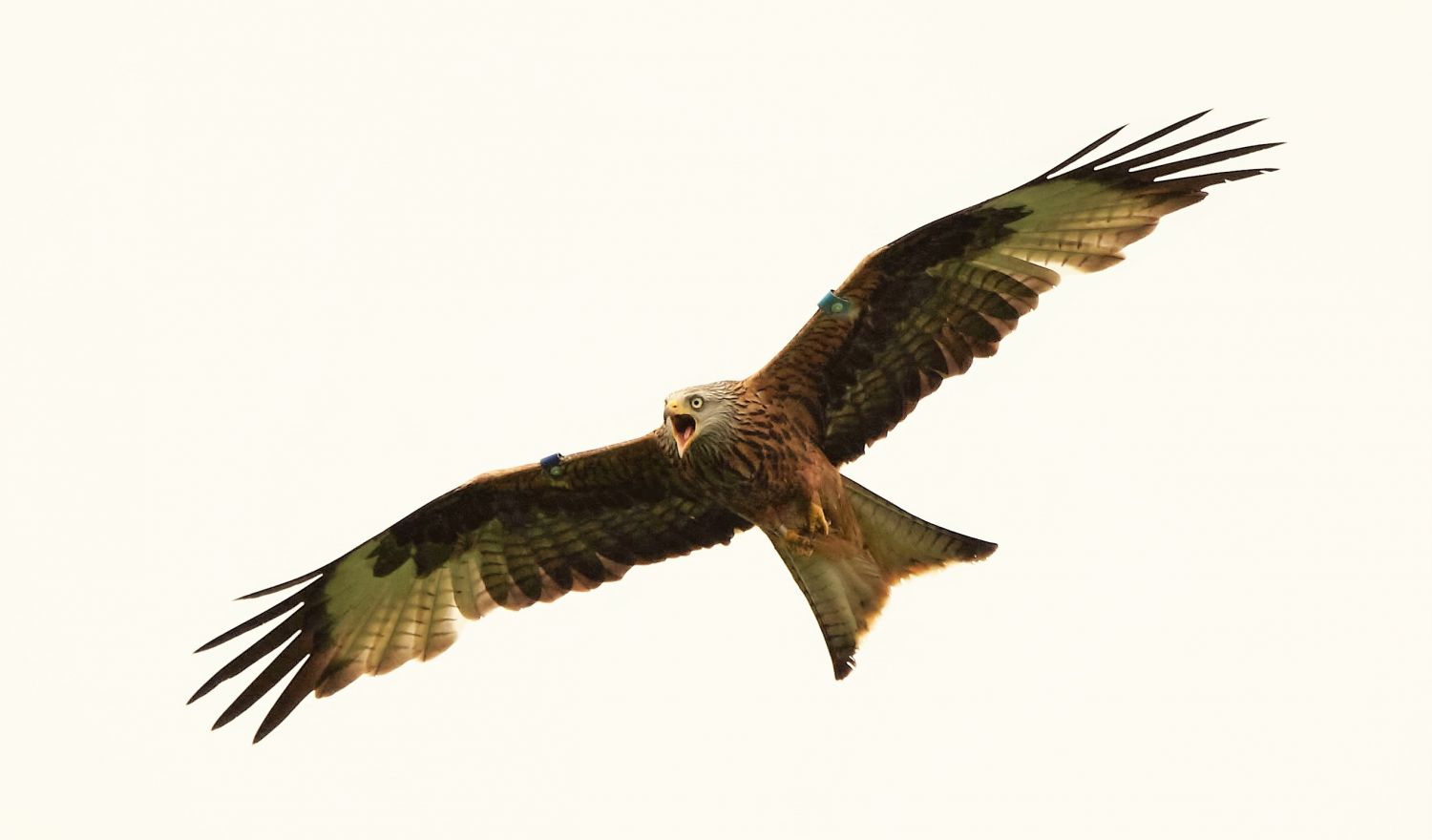
Alarm-calling is usually enough to deter the threat, but for those of us who are not familiar with the sounds of birds of prey may not realise what is happening and continue merrily on our way, getting closer and closer to the nest.
It is rare for a bird to actually make contact but some individual birds are more aggressive, and if frequently disturbed, it may happen. NIRSG get a few reports of these sorts of responses every year. To the nesting bird you are no different from the threat posed by a fox or another bird of prey.
Regular disturbance of a nest site can result in the adults not being able to incubate their eggs efficiently, causing the chicks inside to die, or later in the season defending their nest site from disturbance can distract the adults from hunting or caring for the young and as a result the chicks in the nest may starve. For this reason it is illegal under the wildlife legislation to recklessly disturb ANY bird during the nesting season.
It is best that people stay clear of nesting areas, unless you have wildlife licence, where possible until the breeding season is over, typically around the end of July. We understand that people may be oblivious to the early warning signs that they are approaching an active nest site and it is good to remain vigilant and use your eyes and ears when out and about, particularly if you hear a bird calling repeatedly in the area.
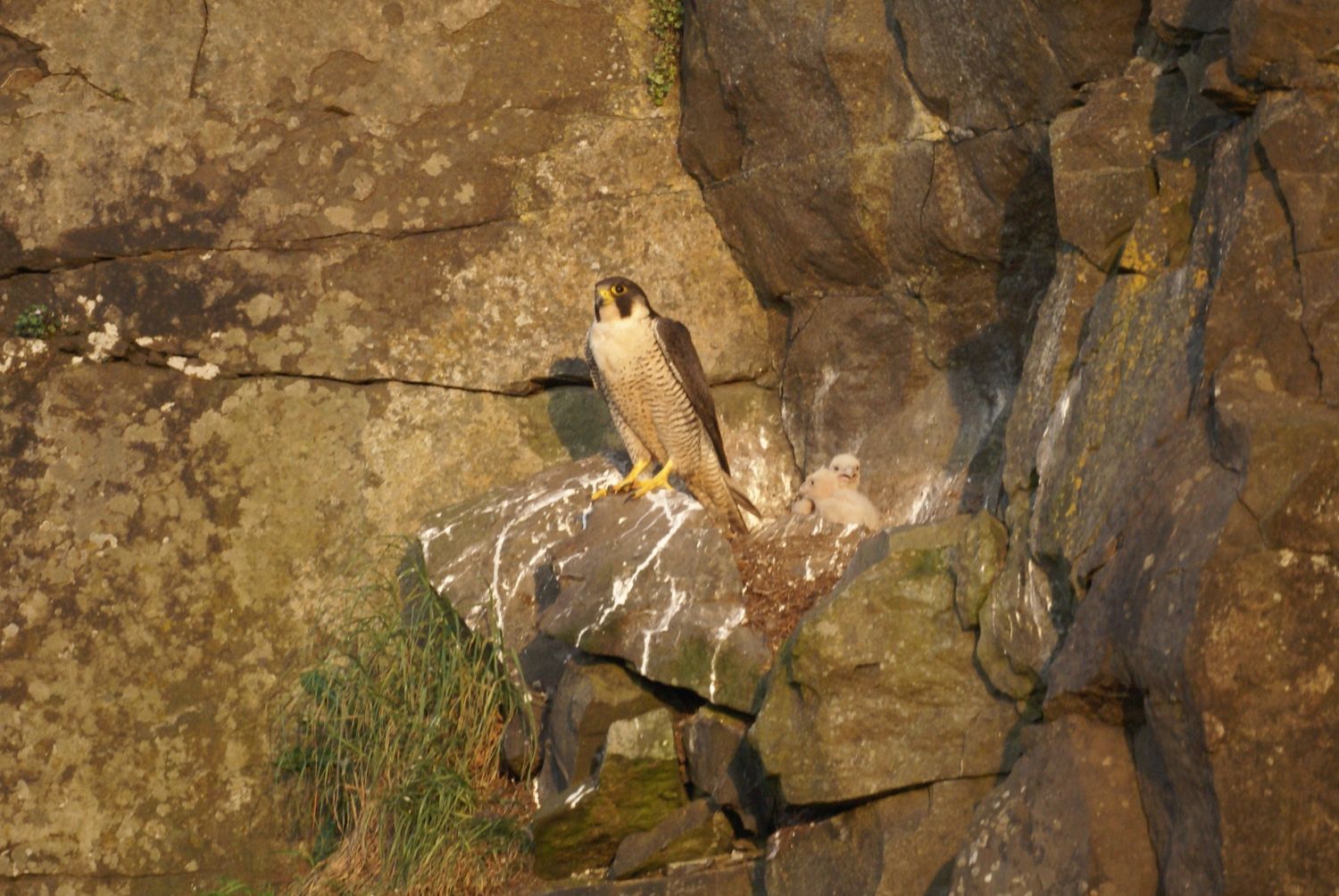 Birds of prey in Northern Ireland are protected all year under the Wildlife (Northern Ireland) Order 1985, as amended by the Wildlife and Environment Act (NI) 2011 and it is illegal to disturb them at, in, on or near their nests. There is a reason for this. Birds of prey sit at the top of their food chain and as a result they are very sensitive to changes in the environment. This leaves each individual very vulnerable and populations can become unstable. The success of their breeding attempts can be affected by disturbance, with eggs and chicks at risk from chilling, predation and starvation when the adults are responding to perceived threats. One or two successive poor breeding years is enough to cause radical declines in some species.
Birds of prey in Northern Ireland are protected all year under the Wildlife (Northern Ireland) Order 1985, as amended by the Wildlife and Environment Act (NI) 2011 and it is illegal to disturb them at, in, on or near their nests. There is a reason for this. Birds of prey sit at the top of their food chain and as a result they are very sensitive to changes in the environment. This leaves each individual very vulnerable and populations can become unstable. The success of their breeding attempts can be affected by disturbance, with eggs and chicks at risk from chilling, predation and starvation when the adults are responding to perceived threats. One or two successive poor breeding years is enough to cause radical declines in some species.
What can you do?
If you are aware of a bird of prey calling when you are out and about, take a few seconds to think, ‘Am I disturbing this bird and could it be calling at me?’ If so, please find an alternative route for the next number of weeks – most bird of prey chicks will have left the nest by the end of July and after this time the defensive behaviour of the adults will lessen.
You can share information about where you are witnessing this protective behaviour and ask other people to avoid the area until the end of the breeding season.
Finally, if you witness any bird of prey being antagonised or disturbed you can call PSNI on ‘101’ or anonymously at Crimestoppers ‘0800 555 111’. This disturbance is, after all, a crime, and should be reported.
Further information
Raptor crimes often comprise illegal shooting, trapping or poisoning events and may occur at any time of the year. It is also illegal to cause disturbance to all raptors or damage their nests or eggs. Wildlife legislation, namely the Wildlife (Northern Ireland) Order 1985 as amended by the Wildlife and Natural Environment (NI) Act 2011 protects birds of prey from disturbance and/or destruction by special penalties. Penalties can include a custodial sentence and/or up to a £5,000 fine per offence.
All raptors are listed on Schedule 1 of the order and there are six raptor species which receive additional protection on Schedule A1 which protects them and their nests from disturbance or destruction at all times of the year. Schedule A1 includes peregrine falcon, red kite, barn owl, golden eagle white-tailed eagle and osprey.
In the spring of 2014, the PAWNI Raptor Priority Sub-Group produced an information leaflet on raptor crime detection and reporting in Northern Ireland which can be downloaded here: https://www.nirsg.com/wp-content/uploads/2014/02/PAWNI-Raptor-Crime-Leaflet.pdf
Police raise concerns after 3 birds found to have been poisoned
Police have raised concerns after three birds of prey (1 Peregrine Falcon and 2 Buzzards) were found dead recently. Following further testing it has been established that two of these birds died linked to Carbofuran poisoning and one found with Alpha chloralose poisoning.
A Peregrine Falcon was found dead at a quarry on the Glenhead Road in Ballymena on April 11th where a Peregrine Falcon was found shot dead in the same area back in 2012 and therefore PSNI requested the poison tests to be expedited.
A Buzzard was found dead at a forest in the Glenarm area on March 15th. Both birds were tested to determine the cause of death and it has been determined that both birds were subject to Carbofuran poisoning.
A third bird (Buzzard) was also reported dead on March 29th also near Glenarm and tests have shown it was exposed to Alphachloralose.
PSNI Wildlife Liaison Officer, Emma Meredith, said, “Poisons can have serious implications and reports such as this give rise to serious concerns. Poison generally is very dangerous and we would have particular concern over any poison but particularly over Carbofuran. We are disappointed that this continues to happen especially with such a dangerous substance, which could kill not only birds of prey but also, a child, family pet or any adult coming into contact with it. We would remind the public if there is a suspicion on any bird of prey to leave the bird/s and/or bait in situ and call the PSNI as soon as possible.
“If anyone has information about the death of these protected birds then we would be really keen to hear from you. The person responsible needs to be identified before other wildlife, domestic pets, or even humans come to harm.
“The PSNI, along with partner agencies (Agri-food and Biosciences Institute, Health and Safety Executive, National Wildlife Crime Unit, Northern Ireland Environment Agency, Northern Ireland Raptor Study Group, Royal Society for Protection of Birds), have been involved in the launch of Operation Raptor, designed to raise the profile of killing of birds of prey and to highlight known “hot spot” areas to combat this type of crime.
The Operation Raptor campaign was launched in March 2016 is designed to encourage members of the public to report to PSNI and also to warn offenders they could face a custodial sentence and/or fine (up to £5,000) if they are caught targeting birds of prey through poisoning, shooting or trapping.”
Anyone with information can contact police on the non-emergency number 101 or anonymously via Crimestoppers on 0800 555 111.
Peregrine falcon found dead in Glenwherry Co. Antrim
A peregrine falcon has been found dead in Glenwherry, Co. Antrim, in Northern Ireland, in the exact same location that a young peregrine was found shot in 2012. The peregrine was discovered on 11th April 2016 and was sent to AFBI for post-mortem. It is strongly suspected that the peregrine has been illegally killed.
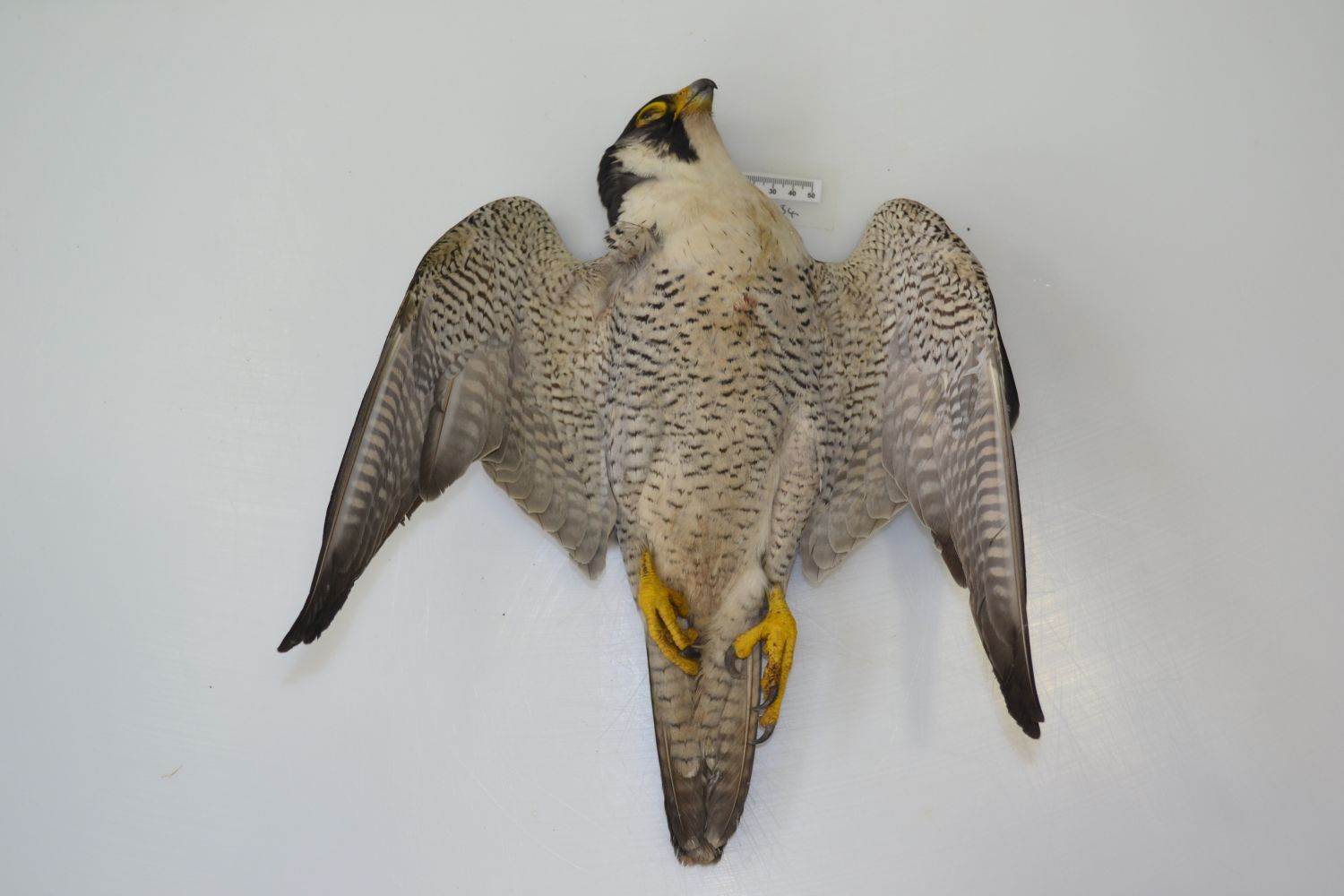
Dr Marc Ruddock from the Northern Ireland Raptor Study Group, who has monitored the peregrines in this area for over a decade along with other volunteers stated: “It is deeply frustrating to think that someone might have gone out of their way to target this bird if the post mortem confirms an illegal act. In 2014 there were only 57 successful breeding peregrine pairs across the whole of Northern Ireland. The loss of a breeding adult has the potential to lead to the desertion of a historical breeding site and widespread persecution could result in serious implications for the viability of the Northern Ireland population of peregrines.”
Dr Ruddock continued “NIRSG volunteers will be increasing surveillance and monitoring at peregrine sites across the country immediately in order to protect nesting sites at this time of year and will report any suspicious activity to the PSNI and would urge the public to be vigilant and also report any suspicious activity or vehicles in the vicinity of any cliffs or quarries immediately to PSNI”.
Wildlife legislation, namely the Wildlife (Northern Ireland) Order 1985 as amended by the Wildlife and Natural Environment (NI) Act 2011, protects all birds of prey from persecution and disturbance during the breeding season by special penalties. Penalties can include fines up to a £5,000 fine per offence and/or a custodial sentence.
Crimes against birds of prey include, but are not limited to, poisoning, trapping and shooting. The setting of poison baits in the open is illegal because it is indiscriminate and has the potential to kill birds of prey as well as other wildlife, pets, livestock and people.
Dr Eimear Rooney, NIRSG representative in the Partnership for Action against Wildlife Crime (PAW), stated: “Disappointingly our fieldworkers detect incidents of raptor crime each year, particularly of peregrine falcons, red kites and buzzards being poisoned or shot. Wildlife crime incidents, particularly where they occur in remote locations, can often go unreported. PAW are working hard to raise awareness both of the law and the protection it affords birds of prey. However, there are clearly still those individuals who are determined to kill birds of prey”.
The NIRSG wishes to send a clear message to these people, persecution of birds of prey will not be tolerated. It does not matter how small each piece of information that members of the public have, it could help the PSNI protect our raptor species and prosecute offenders and would urge people to pass this information either directly to Police on 101 or anonymously to Crimestoppers on 0800 555 111.
The NIRSG are very grateful to the landowners who promptly reported the incident allowing the police to attend the scene very rapidly. Anyone with information on raptor crimes are urged to contact their local PSNI on 101. In March 2016, the PSNI launched Operation Raptor to increase public awareness and encourage reporting of crimes against birds or prey.
________________________________________________________________________________________
• Raptor crimes often comprise illegal shooting, trapping or poisoning events and may occur at any time of the year. It is also illegal to cause disturbance to all raptors or damage their nests or eggs.
• Wildlife legislation, namely the Wildlife (Northern Ireland) Order 1985 as amended by the Wildlife and Natural Environment (NI) Act 2011 protects birds of prey from disturbance and/or destruction by special penalties. Penalties can include a custodial sentence and/or up to a £5,000 fine per offence.
• All raptors are listed on Schedule 1 of the order and there are six raptor species which receive additional protection on Schedule A1 which protects them and their nests from disturbance or destruction at all times of the year. Schedule A1 includes peregrine falcon, red kite, barn owl, golden eagle white-tailed eagle and osprey.
• In the spring of 2014, the PAWNI Raptor Priority Sub-Group produced an information leaflet on raptor crime detection and reporting in Northern Ireland which can be downloaded here: https://www.nirsg.com/wp-content/uploads/2014/02/PAWNI-Raptor-Crime-Leaflet.pdf
• The NIRSG was founded in 1991 and is a voluntary organisation that studies, researches and monitors birds of prey (raptors) across Northern Ireland. We encourage the conservations of raptors and provide information on breeding and wintering raptors to statutory agencies and non-government organisations to ensure effective and practical management and conservation. We raise awareness and profile of all raptor species and inform and assist the police and wildlife agency regarding crimes against raptors. More information can be found at www.nirsg.com
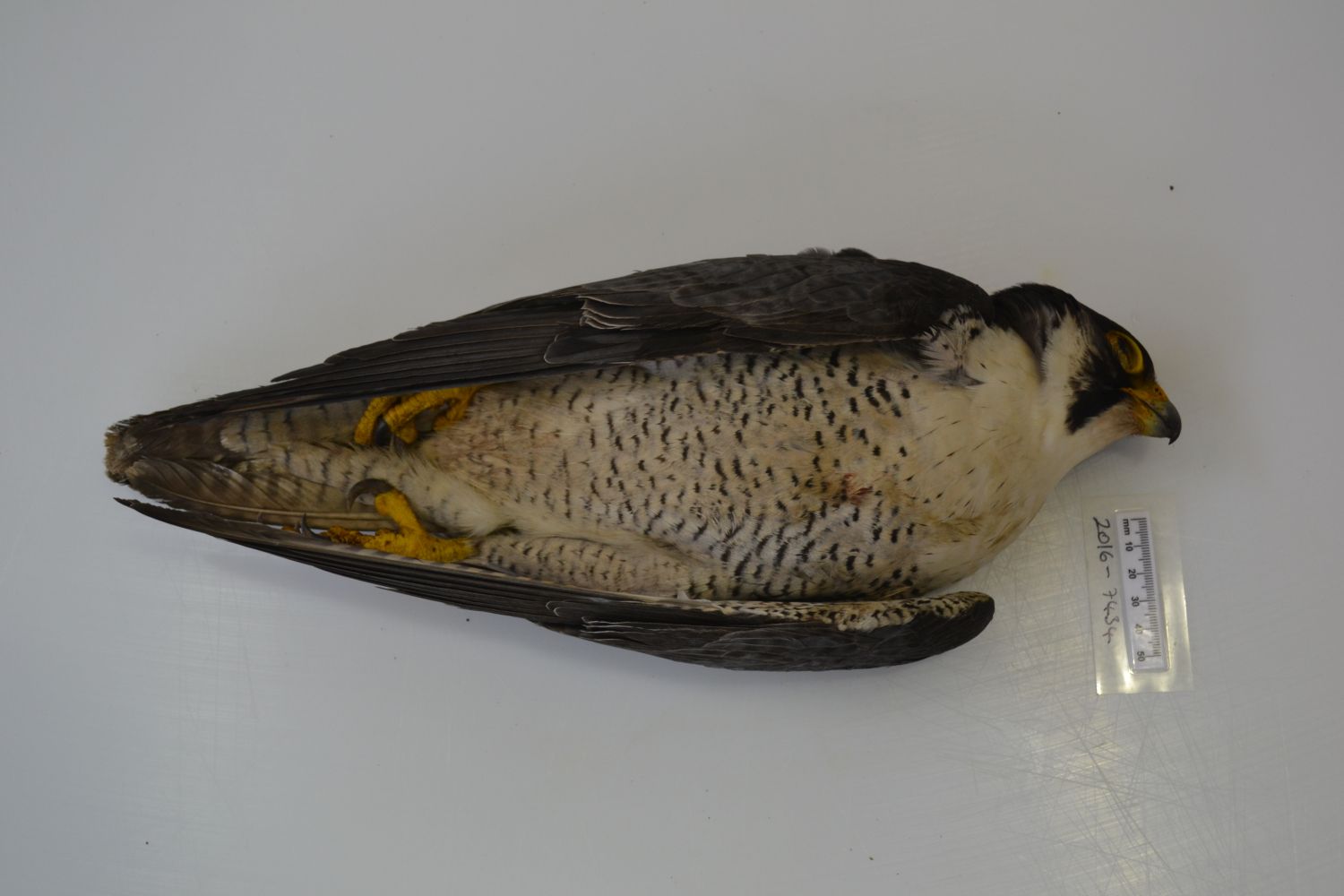
New Report Highlights Raptor Persecution & Poisoning in Northern Ireland
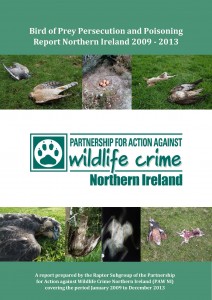 In the five years from 2009 to 2013 there were 30 illegal poisoning or persecution incidents, affecting 33 protected raptors (birds of prey), confirmed in Northern Ireland according to a report published today by the Partnership for Action against Wildlife Crime Northern Ireland (PAWNI).
In the five years from 2009 to 2013 there were 30 illegal poisoning or persecution incidents, affecting 33 protected raptors (birds of prey), confirmed in Northern Ireland according to a report published today by the Partnership for Action against Wildlife Crime Northern Ireland (PAWNI).
The most frequent casualty was the buzzard (19 birds) followed by the recently re-introduced red kite (7 birds) and then peregrine falcons (4 birds). Other raptor species that were recorded included a white-tailed eagle, a golden eagle, sparrowhawk and a merlin.
There were a further 10 confirmed incidents of illegal poisoning of other wildlife or poisoned baits in circumstances where birds of prey were potential victims. Red kites and buzzards, the most frequently recorded victims, are particularly susceptible to poisoned baits as they will feed on carrion routinely.
There were an additional 4 probable raptor crimes (including another white-tailed eagle) and 8 incidents where secondary rodenticide poisoning was recorded.
The report is the result of the work of the Raptor Subgroup of PAWNI facilitating cooperation between the Police Service of Northern Ireland (PSNI), Northern Ireland Environment Agency (NIEA), Northern Ireland Raptor Study Group (NIRSG), Royal Society for Protection of Birds (RSPB) and National Wildlife Crime Unit (NWCU) and analyses the results of post-mortem and toxicology testing carried out via Agri-Food & Biosciences Institute (AFBI) and as reported via the Wildlife Incident Investigation Scheme (WIIS).
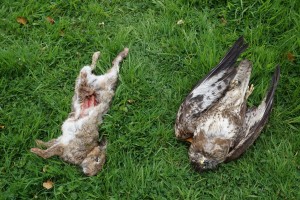 Minister for the Environment and Chair of PAWNI, Mark H. Durkan, welcomed the publication of the report and said “It is a great shame people here are poisoning these wonderful, majestic creatures which brighten up our skies and countryside. I very much condemn the reckless and illegal actions of the minority in our midst who destroy beauty with painful death, leading to the loss of such iconic species. I urge the public to be vigilant and report offenders.”
Minister for the Environment and Chair of PAWNI, Mark H. Durkan, welcomed the publication of the report and said “It is a great shame people here are poisoning these wonderful, majestic creatures which brighten up our skies and countryside. I very much condemn the reckless and illegal actions of the minority in our midst who destroy beauty with painful death, leading to the loss of such iconic species. I urge the public to be vigilant and report offenders.”
Superintendent, Brian Kee, PSNI service lead for rural and wildlife crime, said “This report highlights the continued disregard for public and wildlife safety displayed by a small number of individuals in Northern Ireland. These actions which destroy our native wildlife are illegal and the indiscriminate use of such toxic poisons may affect not only raptors but also children, pets or livestock. I would urge anyone with any information on these types of crimes to report this to the PSNI on 101 or anonymously via Crimestoppers on 0800 555 111 and be assured of PSNI continued efforts in the tackling of wildlife crime”.
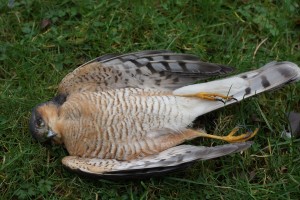 The report lead author, Dr Eimear Rooney (Raptor Officer for NIRSG) said “The overall aim of collating the information in this report was to support government, policy and enforcement agencies to help us all, from authorities to the general public, to understand the scale and distribution of these incidents. I cannot bear to think about the deaths of these individuals, in particular the losses of both golden and white-tailed eagles and red kites, which may have a devastating impact on the survival of these populations. Working with a range of experts via the PAWNI Raptor Subgroup has allowed us to share our data and experience and produce this robust assessment which we aim to update annually.”
The report lead author, Dr Eimear Rooney (Raptor Officer for NIRSG) said “The overall aim of collating the information in this report was to support government, policy and enforcement agencies to help us all, from authorities to the general public, to understand the scale and distribution of these incidents. I cannot bear to think about the deaths of these individuals, in particular the losses of both golden and white-tailed eagles and red kites, which may have a devastating impact on the survival of these populations. Working with a range of experts via the PAWNI Raptor Subgroup has allowed us to share our data and experience and produce this robust assessment which we aim to update annually.”
RSPB, NIRSG and NWCU have further welcomed the publication of the report as another step towards identifying the national frequency, timing and locations of these crimes in Northern Ireland. The publication of this report demonstrates the value of collaborative working by these organisations to help monitor and record raptor persecution in a strategic effort to identify “hot-spot” areas and help tackle the issues as well as increase public awareness and education.
PAWNI Raptor Persecution & Poisoning Report 2009-2013 FINAL (PDF)
To Download Press Image 1 Click Here
To Download Press Image 2 Click Here
To Download Press Image 3 Click Here
Notes to editor:
- Raptor Persecution is one of the UK government’s top six Wildlife Crime Priorities. Raptor crimes typically comprise illegal shooting, trapping or poisoning events and may occur at any time of the year. It is also illegal to cause disturbance to all breeding raptors or damage their nests or eggs.
- The Raptor Priority Subgroup comprises Police Service of Northern Ireland (PSNI); Northern Ireland Environment Agency (NIEA); National Wildlife Crime Unit (NWCU); Northern Ireland Raptor Study Group (NIRSG) and the Royal Society for Protection of Birds (RSPB). The Raptor Priority Sub-Group is acting on behalf of and reports back to the main PAWNI group currently chaired by the Environment Minister, Mark H. Durkan.
- Wildlife legislation, namely the Wildlife (Northern Ireland) Order 1985 as amended by the Wildlife and Natural Environment (NI) Act 2011 protects birds of prey from disturbance and/or destruction by special penalties. Penalties can include a custodial sentence and/or up to a £5,000 fine per offence.
- All raptors are listed on Schedule 1 of the order and there are six raptor species which receive additional protection on Schedule A1 which protects them and their nests from disturbance or destruction at all times of the year. Schedule A1 includes peregrine falcon, red kite, barn owl, golden eagle white-tailed eagle and osprey.
- The Campaign for Responsible Rodenticide Use (CRRU) aims to promote best practice so that rat poisons (rodenticides) in particular should not get into the wildlife food chain where it harms owls, kites and other birds of prey. More information on this can be found at www.thinkwildlife.org
- A leaflet outlining the protocol for reporting raptor crimes was previously produced by the Raptor Subgroup and is available for download at the following link: https://www.nirsg.com/wp-content/uploads/2014/02/PAWNI-Raptor-Crime-Leaflet.pdf
- More information on the Wildlife Incident Investigation Scheme (WIIS) is available at: http://www.pesticides.gov.uk/guidance/industries/pesticides/topics/reducing-environmental-impact/wildlife
- For additional enquiries please contact Dr Eimear Rooney; raptorofficerni@gmail.com; 07743068931.
Buzzard Mobbing Behaviour – June 2015
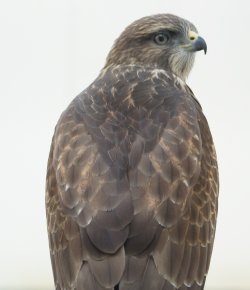 During the breeding season many animals defend their territories and breeding sites from potential danger and birds of prey are no exception. Birds of prey will ‘alarm call’ at any perceived threat that comes too close to their nest site. On rarer occasions they may dive at the threat if it persists, and even make contact with it. This is a natural response which can be observed by many different types of wildlife. For example, many of us are familiar with being ‘dive-bombed’ by gulls.
During the breeding season many animals defend their territories and breeding sites from potential danger and birds of prey are no exception. Birds of prey will ‘alarm call’ at any perceived threat that comes too close to their nest site. On rarer occasions they may dive at the threat if it persists, and even make contact with it. This is a natural response which can be observed by many different types of wildlife. For example, many of us are familiar with being ‘dive-bombed’ by gulls.
Alarm-calling is usually enough to deter the threat, but for those of us who are not familiar with the sounds of birds of prey may not realise what is happening and continue merrily on our way, getting closer and closer to the nest. It is rare for a bird to actually make contact but it does happen and NIRSG get a few reports every year at sites where a bird is repeatedly disturbed and aggressive mobbing or ‘attacks’ may occur.
We can provide information if required and ask people to stay clear of the area for a few weeks until the height of the breeding season is over. However, this year, the media have picked up on a small number of nest sites in particular where buzzards are particularly aggressive and are making contact with people who are oblivious to the early warning signs that they are approaching an active nest site. In these cases the buzzards have unfortunately nested very close to active pathways or roads and as a result are being frequently disturbed each day. The buzzard nesting season typically extends from March through to July or early August each year but young are only typically in their nests between May and late June or early July.
‘Attacks’ or mobbing behaviours may increase in ferocity throughout the season as a learned behaviour which you get with any bird – if it makes contact and it is successful in making the threat leave then it learns to perhaps do this quicker and harder next time so the threat will leave quicker. The more birds are disturbed the more aggressive they may become, and this goes for most nesting birds, including gulls, terns and waders. Every individual bird may be totally different in their response to disturbance and the majority will perhaps alarm call and then fly high overhead calling continuously and it is important for people to try and understand what these behaviours and calls might mean and minimise such negative impacts on our wildlife.
Birds of prey in Northern Ireland are protected under the Wildlife (Northern Ireland) Order 1985, as amended by the Wildlife & Natural Environment Act (NI) 2011 and it is illegal to disturb them at, in, on or near their nests. Such offences may be subject to a custodial sentence and/or £5,000 fine per offence. There is a reason for this. Birds of prey sit at the top of their food chain and thus are very sensitive to changes in the environment. This leaves them as very vulnerable species whose populations are unstable. The success of their breeding attempts can be affected by disturbance, with eggs and chicks at risk from chilling, predation and starvation when the adults are responding to perceived threats. One or two successive poor breeding years is enough to cause radical declines in some species.
What can you do?
If you are aware of a bird of prey calling when you are out an about, take a few seconds to think, am I disturbing this bird and could it be calling at me? If so, please find an alternative route for the next number of weeks. We would therefore advocate avoidance as the means to prevent such disturbance to the buzzards and their nests and thereby also avoid any associated mobbing and defensive behaviours.
Buzzard chicks are generally large enough to be left alone by the adults by mid-late June and they leave the nest around the first week of July. Over this time the defensive behaviour of the adults will decrease and the mobbing behaviour will not then typically occur. These birds are only protecting their young.
You can let NIRSG know whereabouts you are witnessing this protective behaviour and we can take action by putting up signage asking people to find an alternative route until the end of the breeding season (email: info@nirsg.com or raptorofficerni@gmail.com).
Finally, if you witness any bird of prey being antagonised or disturbed you can call PSNI on ‘101’ or anonymously at Crimestoppers ‘0800 555 111’. This disturbance may, after all, be a crime, and should be reported.